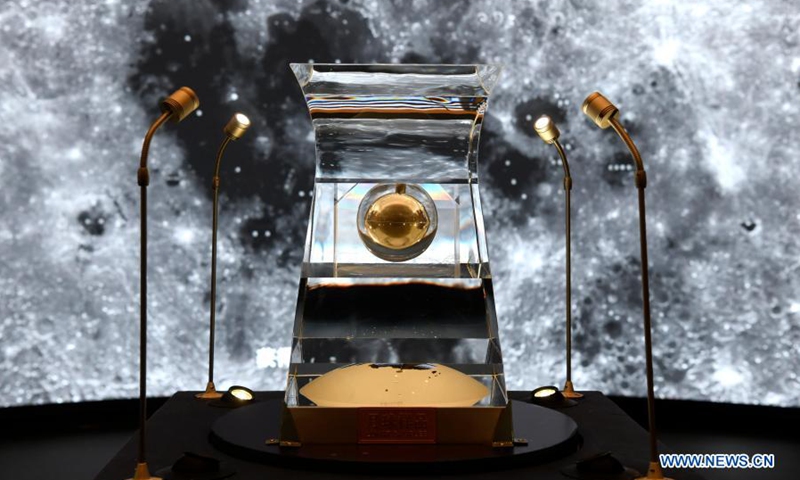Chinese institutes to study habitability of the Moon as lunar soil is distributed to researchers

The lunar samples No. 001 brought back by China's Chang'e-5 probe is displayed at the National Museum of China in Beijing, capital of China, Feb. 27, 2021. An exhibition displaying the lunar samples No. 001 brought back by China's Chang'e-5 probe is held here on Saturday.(Photo: Xinhua)
China on Monday officially launched the scientific research on the Moon samples brought back by the Chang’e-5 mission last December. The first batch of some 17 grams of lunar soils was handed out to 13 research institutes. Studies of the soil will probe into subjects untouched by previous Soviet Union and US researchers on the habitability of the Earth’s celestial neighbor.
Among the 85 applications from 23 organizations, 31 applications from the 13 institutes have been approved to do the research work, including the Chinese Academy of Sciences, China University of Geosciences, and Sun Yat-Sen University, authorities from China's Lunar Exploration Program (CLEP) under the China National Space Administration (CNSA) announced at a ceremony held in Beijing on Monday.
The first batch of lunar soil handed out to the researchers weighs a total of 17.4764 grams. While the Chang'e-5 used a combination of a scoop and drilling equipment that dug into deeper ground to collect moon’s surface materials, the distributed soil this time was all from the moon’s surface, according to China Space News.
“Every bit of it is precious, requiring us to do our utmost to protect the samples and minimize losses during researches,” Liu Jizhong, director of CLEP, said at the ceremony.
He added that more samples will be released and distributed as planned and he invited more research institutes to join in the study. The next application review for lunar soil studies is scheduled in September.
China is willing to share lunar samples and exploration data with institutions and scientists all over the world for scientific analysis, Wu Yanhua, deputy director of the CNSA, said earlier in December when the Moon materials were brought back with the Chang’e-5 return capsule.
Directions for the scientific researches will mainly involve the lunar surfacing process, lunar volcanic activities, and the Moon’s evolution. The researchers will probe into subjects untouched by previous Soviet Union and US researchers on the habitability of the Moon, Our Space, the official WeChat account operating under China Manned Space Agency, reported.
Soils collected by Chang’e-5 probe are from a site that had never been visited before, and contains materials from 1.2 billion years ago. Many believe this will fill the gap in our understanding of the moon’s volcanic activities.
The CNSA is also planning to send part of the Moon soil to Shaoshan, Central China's Hunan Province, the hometown of late Chinese leader Mao Zedong, officials revealed at the press conference.
The decision was made not only to commemorate the late leader, who once expressed his admiration and wonder for space when he said, "We can clasp the Moon in the Ninth Heaven and seize turtles deep down in the Five Seas," but also out of considerations for the favorable geological conditions in Shaoshan. These conditions will be suitable for disaster recovery and backup.
The Chang’e-5 lunar probe concluded its epic journey on December 17, 2020. The returning capsule brought with it a total of 1,731 grams of lunar soil. It successfully landed in Siziwang Banner, North China's Inner Mongolia Autonomous Region.
Parts of the soil have been displayed to the public at the Great Hall of the People, the National Museum of China, East China’s Jiangsu Province, and Hong Kong Special Administrative Region earlier this month, attracting floods of people who are earnest to take a glimpse of “the gift from heaven.”
Global Times
